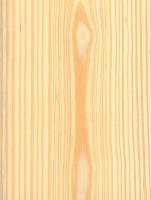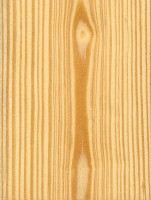 |
Common Name(s): Maritime Pine Scientific Name: Pinus pinaster Distribution: Southwestern Europe; also grown on plantations in Europe Tree Size: 65-115 ft (20-35 m) tall, 2-4 ft (.6-1.2 m) trunk diameter Average Dried Weight: 31 lbs/ft3 (500 kg/m3) Specific Gravity (Basic, 12% MC): .39, .50 Janka Hardness: 390 lbf (1,740 N) Modulus of Rupture: 10,590 lbf/in2 (73.0 MPa) Elastic Modulus: 1,238,000 lbf/in2 (8.54 GPa) Crushing Strength: 5,660 lbf/in2 (39.0 MPa) Shrinkage: Radial: 4.5%, Tangential: 9.0%, Volumetric: 14.4%, T/R Ratio: 2.0 |
Color/Appearance: Heartwood is light reddish brown, demarcated sapwood is pale yellow to nearly white. Color tends to darken with age.
Grain/Texture: Grain is straight, with a medium, even texture.
Rot Resistance: The heartwood is rated as moderate to low in decay resistance.
Workability: Overall, Maritime Pine works fairly well with most tools, though the resin can gum up tools and clog sandpaper. Maritime Pine glues and finishes well.
Odor: Maritime Pine has a distinct, resinous odor when being worked.
Allergies/Toxicity: Working with pine has been reported to cause allergic skin reactions and/or asthma-like symptoms in some people. See the articles Wood Allergies and Toxicity and Wood Dust Safety for more information.
Pricing/Availability: Maritime Pine is extensively grown on plantations in France, Spain, and Portugal for use as construction lumber. Prices within its natural range should be moderate.
Sustainability: This wood species is not listed in the CITES Appendices, and is reported by the IUCN as being a species of least concern.
Common Uses: Paper (pulpwood), flooring, boxes/crates, and construction lumber.
Comments: Although Maritime Pine has been grown on plantations throughout the world, its use outside of Europe has been largely replaced by Radiata Pine (Pinus radiata) because it reportedly provides larger and better lumber. However, Maritime Pine is still an important plantation tree within Europe, and provides not only lumber, but also resin for turpentine.
- Austrian Pine (Pinus nigra)
- Caribbean Pine (Pinus caribaea)
- Eastern White Pine (Pinus strobus)
- Jack Pine (Pinus banksiana)
- Jeffrey Pine (Pinus jeffreyi)
- Khasi Pine (Pinus kesiya)
- Limber Pine (Pinus flexilis)
- Loblolly Pine (Pinus taeda)
- Lodgepole Pine (Pinus contorta)
- Longleaf Pine (Pinus palustris)
- Ocote Pine (Pinus oocarpa)
- Patula Pine (Pinus patula)
- Pinyon Pine (Pinus edulis)
- Pitch Pine (Pinus rigida)
- Pond Pine (Pinus serotina)
- Ponderosa Pine (Pinus ponderosa)
- Radiata Pine (Pinus radiata)
- Red Pine (Pinus resinosa)
- Sand Pine (Pinus clausa)
- Scots Pine (Pinus sylvestris)
- Shortleaf Pine (Pinus echinata)
- Slash Pine (Pinus elliottii)
- Spruce Pine (Pinus glabra)
- Sugar Pine (Pinus lambertiana)
- Sumatran Pine (Pinus merkusii)
- Table Mountain Pine (Pinus pungens)
- Western White Pine (Pinus monticola)
- Virginia Pine (Pinus virginiana)
Scans/Pictures: There are currently no pictures of this exact wood species, but a similar species within the Pinus genus is being substituted (P. sylvestris). If you’d like to contribute a wood sample of this specific species to be scanned, (even small pieces of veneer can be sent), please use the contact form.
 |
 |





In the Mediterranean region there is also the stone pine (pinus pinea). The wood has been used for centuries in shipbuilding, providing the curved frames, while the planking was marittime pine. It is harvested for pine nuts, and provides good shade (wide) in parks and nature.